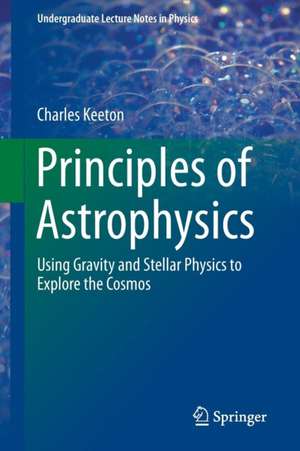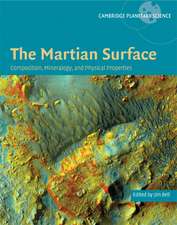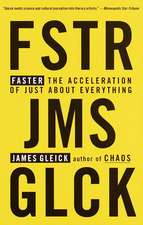Principles of Astrophysics: Using Gravity and Stellar Physics to Explore the Cosmos: Undergraduate Lecture Notes in Physics
Autor Charles Keetonen Limba Engleză Paperback – 11 mai 2014
This book gives a survey of astrophysics at the advanced undergraduate level, providing a physics-centred analysis of a broad range of astronomical systems. It originates from a two-semester course sequence at Rutgers University that is meant to appeal not only to astrophysics students but also more broadly to physics and engineering students. The organisation is driven more by physics than by astronomy; in other words, topics are first developed in physics and then applied to astronomical systems that can be investigated, rather than the other way around.
The first half of the book focuses on gravity. The theme in this part of the book, as well as throughout astrophysics, is using motion to investigate mass. The goal of Chapters 2-11 is to develop a progressively richer understanding of gravity as it applies to objects ranging from planets and moons to galaxies and the universe as a whole. The second half uses other aspects of physics to address one of the bigquestions. While “Why are we here?” lies beyond the realm of physics, a closely related question is within our reach: “How did we get here?” The goal of Chapters 12-20 is to understand the physics behind the remarkable story of how the Universe, Earth and life were formed. This book assumes familiarity with vector calculus and introductory physics (mechanics, electromagnetism, gas physics and atomic physics); however, all of the physics topics are reviewed as they come up (and vital aspects of vector calculus are reviewed in the Appendix).
Din seria Undergraduate Lecture Notes in Physics
- 17%
 Preț: 362.11 lei
Preț: 362.11 lei -
 Preț: 398.45 lei
Preț: 398.45 lei -
 Preț: 265.30 lei
Preț: 265.30 lei - 15%
 Preț: 478.05 lei
Preț: 478.05 lei -
 Preț: 371.85 lei
Preț: 371.85 lei - 17%
 Preț: 364.52 lei
Preț: 364.52 lei - 15%
 Preț: 620.25 lei
Preț: 620.25 lei - 17%
 Preț: 363.03 lei
Preț: 363.03 lei - 17%
 Preț: 427.77 lei
Preț: 427.77 lei -
 Preț: 493.12 lei
Preț: 493.12 lei - 18%
 Preț: 789.98 lei
Preț: 789.98 lei -
 Preț: 385.10 lei
Preț: 385.10 lei -
 Preț: 398.12 lei
Preț: 398.12 lei -
 Preț: 401.24 lei
Preț: 401.24 lei - 13%
 Preț: 358.33 lei
Preț: 358.33 lei - 17%
 Preț: 362.93 lei
Preț: 362.93 lei -
 Preț: 472.29 lei
Preț: 472.29 lei - 17%
 Preț: 363.47 lei
Preț: 363.47 lei -
 Preț: 338.97 lei
Preț: 338.97 lei - 17%
 Preț: 364.56 lei
Preț: 364.56 lei - 20%
 Preț: 579.76 lei
Preț: 579.76 lei - 17%
 Preț: 365.68 lei
Preț: 365.68 lei - 17%
 Preț: 366.61 lei
Preț: 366.61 lei - 17%
 Preț: 432.41 lei
Preț: 432.41 lei -
 Preț: 372.36 lei
Preț: 372.36 lei -
 Preț: 359.53 lei
Preț: 359.53 lei -
 Preț: 397.25 lei
Preț: 397.25 lei -
 Preț: 317.55 lei
Preț: 317.55 lei -
 Preț: 229.57 lei
Preț: 229.57 lei - 15%
 Preț: 538.28 lei
Preț: 538.28 lei -
 Preț: 468.02 lei
Preț: 468.02 lei -
 Preț: 428.07 lei
Preț: 428.07 lei -
 Preț: 637.07 lei
Preț: 637.07 lei -
 Preț: 582.65 lei
Preț: 582.65 lei -
 Preț: 424.77 lei
Preț: 424.77 lei -
 Preț: 446.96 lei
Preț: 446.96 lei - 15%
 Preț: 515.30 lei
Preț: 515.30 lei -
 Preț: 348.22 lei
Preț: 348.22 lei -
 Preț: 313.45 lei
Preț: 313.45 lei -
 Preț: 319.43 lei
Preț: 319.43 lei - 15%
 Preț: 509.58 lei
Preț: 509.58 lei - 15%
 Preț: 507.95 lei
Preț: 507.95 lei -
 Preț: 361.29 lei
Preț: 361.29 lei -
 Preț: 453.21 lei
Preț: 453.21 lei -
 Preț: 453.01 lei
Preț: 453.01 lei - 15%
 Preț: 722.67 lei
Preț: 722.67 lei -
 Preț: 392.21 lei
Preț: 392.21 lei -
 Preț: 383.71 lei
Preț: 383.71 lei
Preț: 429.08 lei
Preț vechi: 516.97 lei
-17% Nou
Puncte Express: 644
Preț estimativ în valută:
82.10€ • 85.72$ • 67.95£
82.10€ • 85.72$ • 67.95£
Carte disponibilă
Livrare economică 14-28 martie
Livrare express 27 februarie-05 martie pentru 38.34 lei
Preluare comenzi: 021 569.72.76
Specificații
ISBN-13: 9781461492351
ISBN-10: 1461492351
Pagini: 409
Ilustrații: XXI, 434 p. 119 illus., 37 illus. in color.
Dimensiuni: 155 x 235 x 27 mm
Greutate: 0.66 kg
Ediția:2014
Editura: Springer
Colecția Springer
Seria Undergraduate Lecture Notes in Physics
Locul publicării:New York, NY, United States
ISBN-10: 1461492351
Pagini: 409
Ilustrații: XXI, 434 p. 119 illus., 37 illus. in color.
Dimensiuni: 155 x 235 x 27 mm
Greutate: 0.66 kg
Ediția:2014
Editura: Springer
Colecția Springer
Seria Undergraduate Lecture Notes in Physics
Locul publicării:New York, NY, United States
Public țintă
Upper undergraduateCuprins
Introduction: Tools of the Trade.- Part I: Using Gravity and Motion to Measure Mass.- Celestial Mechanics.- Gravitational One-Body Problem.- Gravitational Two-Body Problem.- Tidal Forces.- Gravitational Three-Body Problem.- Extended Mass Distributions: Spiral Galaxies.- N-Body Problem: Elliptical Galaxies.- Bending of Light by Gravity.- Relativity.- Cosmology: Expanding Universe.- Part II: Using Stellar Physics to Explore the Cosmos.- Planetary Atmospheres.- Planetary Temperatures.- Stellar Atmospheres.- Nuclear Fusion.- Stellar Structure and Evolution.- Stellar Remnants.- Charting the Universe with Stars.- Star and Planet Formation.- Cosmology: Early Universe.- Part III: Appendices.- Appendix A: Technical Background.- Appendix B: Solutions.
Recenzii
From the book reviews:
“The book is divided into two parts, each part corresponding to a one semester course. … This book is an excellent introduction to astrophysics. It can be used as a text for courses on the subject. Problems are included at the end of each chapter with solutions in the back. Also, each chapter ends with a list of references for further study.” (Stephen Wollman, zbMATH, Vol. 1302, 2015)
“The book is divided into two parts, each part corresponding to a one semester course. … This book is an excellent introduction to astrophysics. It can be used as a text for courses on the subject. Problems are included at the end of each chapter with solutions in the back. Also, each chapter ends with a list of references for further study.” (Stephen Wollman, zbMATH, Vol. 1302, 2015)
Notă biografică
Charles Keeton earned a B.A. in Physics (summa cum laude) from Cornell University in 1994, and a Ph.D. in Physics from Harvard University in 1998. He held the Bart J. Bok Fellowship at the University of Arizona and a NASA Hubble Fellowship at the University of Chicago before joining the faculty of Rutgers University in 2004. Keeton has published 89 refereed journal articles in major international astronomy journals. He has received the following awards:
•2007: Rutgers Society of Physics Students, Outstanding Teacher Award
•2010: White House, Presidential Early Career Award for Scientists and Engineers
•2010: Rutgers University, Presidential Fellowship for Teaching Excellence
•2010: Rutgers University, Board of Trustees Fellowship for Scholarly Excellence
In 2011, Keeton was named Faculty Director of the Aresty Research Center for Undergraduates at Rutgers University.
•2007: Rutgers Society of Physics Students, Outstanding Teacher Award
•2010: White House, Presidential Early Career Award for Scientists and Engineers
•2010: Rutgers University, Presidential Fellowship for Teaching Excellence
•2010: Rutgers University, Board of Trustees Fellowship for Scholarly Excellence
In 2011, Keeton was named Faculty Director of the Aresty Research Center for Undergraduates at Rutgers University.
Textul de pe ultima copertă
This book gives a survey of astrophysics at the advanced undergraduate level. It originates from a two-semester course sequence at Rutgers University that is meant to appeal not only to astrophysics students but also more broadly to physics and engineering students. The organization is driven more by physics than by astronomy; in other words, topics are first developed in physics and then applied to astronomical systems that can be investigated, rather than the other way around.
The first half of the book focuses on gravity. Gravity is the dominant force in many astronomical systems, so a tremendous amount can be learned by studying gravity, motion and mass. The theme in this part of the book, as well as throughout astrophysics, is using motion to investigate mass. The goal of Chapters 2-11 is to develop a progressively richer understanding of gravity as it applies to objects ranging from planets and moons to galaxies and the universe as a whole. The second half uses other aspects of physics to address one of the big questions. While “Why are we here?” lies beyond the realm of physics, a closely related question is within our reach: “How did we get here?” The goal of Chapters 12-21 is to understand the physics behind the remarkable story of how the Universe, Earth and life were formed. This book assumes familiarity with vector calculus and introductory physics (mechanics, electromagnetism, gas physics and atomic physics); however, all of the physics topics are reviewed as they come up (and vital aspects of vector calculus are reviewed in the Appendix).
This volume is aimed at undergraduate students majoring in astrophysics, physics or engineering.
The first half of the book focuses on gravity. Gravity is the dominant force in many astronomical systems, so a tremendous amount can be learned by studying gravity, motion and mass. The theme in this part of the book, as well as throughout astrophysics, is using motion to investigate mass. The goal of Chapters 2-11 is to develop a progressively richer understanding of gravity as it applies to objects ranging from planets and moons to galaxies and the universe as a whole. The second half uses other aspects of physics to address one of the big questions. While “Why are we here?” lies beyond the realm of physics, a closely related question is within our reach: “How did we get here?” The goal of Chapters 12-21 is to understand the physics behind the remarkable story of how the Universe, Earth and life were formed. This book assumes familiarity with vector calculus and introductory physics (mechanics, electromagnetism, gas physics and atomic physics); however, all of the physics topics are reviewed as they come up (and vital aspects of vector calculus are reviewed in the Appendix).
This volume is aimed at undergraduate students majoring in astrophysics, physics or engineering.
Caracteristici
Provides a physics-centered analysis of a broad range of astronomical systems that appeals to a large audience of advanced undergraduate students in physics and engineering Illustrates estimation techniques that professional physicists and astronomers use in their research Emerges from lecture notes that have been used for nine years by three professors, all of whom have received Outstanding Teacher Awards from the Rutgers Society of Physics Students while teaching the course Includes supplementary material: sn.pub/extras












